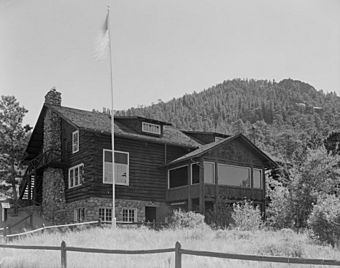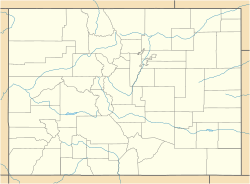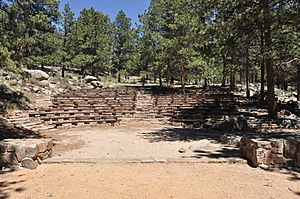Moraine Park Museum and Amphitheater facts for kids
|
Moraine Park Museum and Amphitheater
|
|

Moraine Park Museum
|
|
| Nearest city | Estes Park, Colorado |
|---|---|
| Built | 1923 |
| Architect | National Park Service; Civilian Conservation Corps |
| MPS | Rocky Mountain National Park MPS |
| NRHP reference No. | 76000206 (original) 05000602 (increase) |
Quick facts for kids Significant dates |
|
| Added to NRHP | October 8, 1976 |
| Boundary increase | June 15, 2005 |
The Moraine Park Museum and Amphitheater are special places in Rocky Mountain National Park. They are also known as the Moraine Park Lodge and the Moraine Park Visitor Center. You can find them in Moraine Park, which is a beautiful, flat meadow. This meadow sits between two moraines, which are hills made by glaciers long ago.
These two buildings were created to help people visiting the park. Both are listed on the National Register of Historic Places, meaning they are important historical sites. The museum building was first built in 1923. A woman named Imogene Green MacPherson started it as a private place for tourists. It was called the Moraine Park Lodge back then.
The National Park Service bought the property in 1931. They later removed the cabins that were around it. The amphitheater was designed and built in 1935. The National Park Service planned it, and the Civilian Conservation Corps (CCC) built it. The CCC was a group that helped people find jobs during the Great Depression. The lodge building was also updated in 1934-1935. Both buildings show the "National Park Service Rustic" style. This means they use natural materials like stone and logs to fit in with the park's beauty.
Contents
Early History of Moraine Park Lodge
Imogene Green MacPherson first settled in Moraine Park in 1903. She named her land "Hillcrest." In 1905, after she got married, she made her property bigger. She added a lodge, a dining hall, a stable, and some cabins for guests. People started paying to stay there in 1910.
Mrs. MacPherson kept running the resort even after her husband passed away in 1919. She also helped with the effort to create Rocky Mountain National Park. After she passed away in 1928, her family continued to run the lodge. The National Park Service then bought it from them.
The Amphitheater's Design
The amphitheater is about 100 feet away from the lodge. It has seating mixed in with trees, making it feel very natural. There used to be a screen and a booth for showing movies, but these were removed. The builders also created a clever system of stone gutters and drains. This helps to manage water and keep the area dry.
The Moraine Park Lodge is also next to the William Allen White Cabins historic district.
What You Can See at the Museum
Today, the museum has fun, interactive exhibits about nature. You can learn about how mountains are formed by geology and how glaciers shaped the land. It also teaches about weather, climate, and different ecosystems. You can also learn about how humans affect the environment. The park offers special programs for learning about these topics too.
The lodge building was first listed on the National Register of Historic Places on October 8, 1976. The listing was later expanded on June 15, 2005, to include the amphitheater.
Moraine Park Meadows
The Moraine Park valley was created by an ancient glacial lake. Over time, the lake filled with dirt and drained away. This left behind the flat, open meadow you see today. The soil here is often wet, so most large trees do not grow well. Instead, you will find grasses, willows, and aspens.
The Big Thompson River flows through this valley. It comes down from Forest Canyon, which was carved by glaciers. This area is home to ponderosa pine, aspen, and douglas-fir trees. It also has many large and small meadows. Moraine Park is a great place to see elk. Many elk gather here in the fall for their mating season, called the rut.
See also




